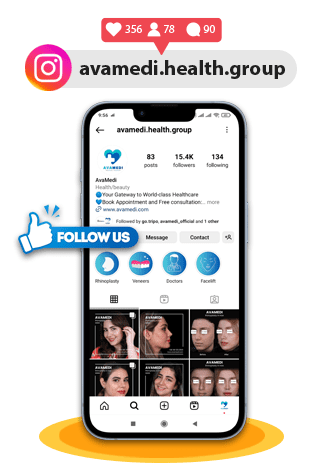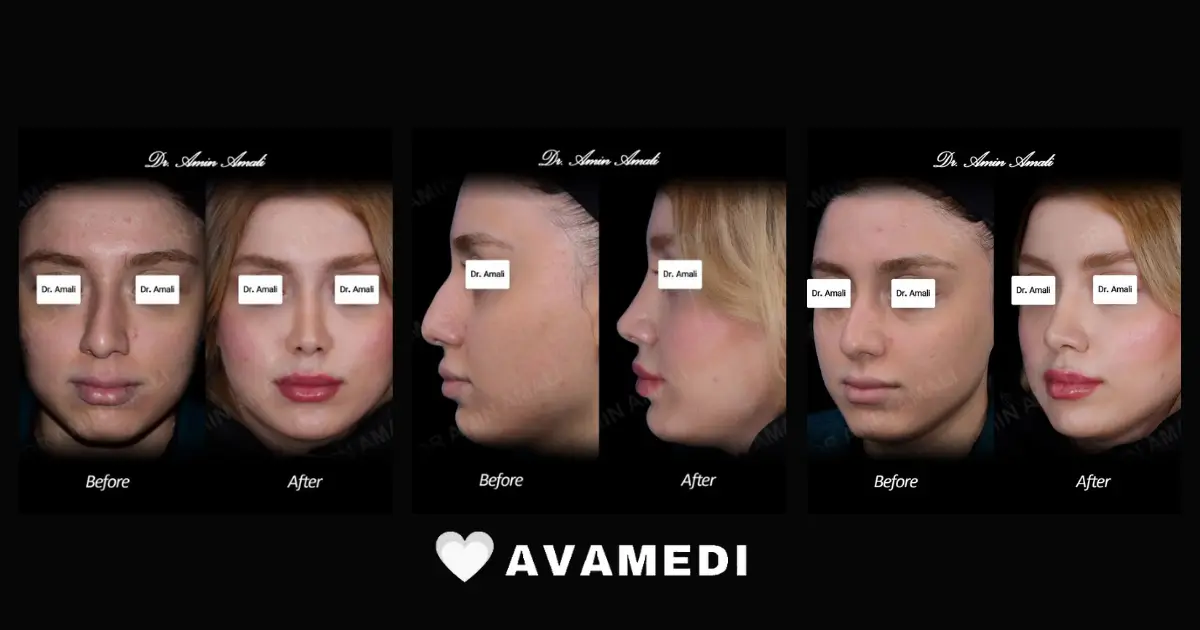What is a Persian Nose Job?
A Persian nose job, also known as Persian rhinoplasty, is a surgical procedure designed to reshape and refine the nose of individuals with Persian heritage. Persian nose surgery is tailored to address the unique characteristics and aesthetic preferences of Persian noses.
Unlike traditional rhinoplasties, Persian nose jobs often emphasize preserving the nose’s natural shape and cultural identity while making subtle enhancements. This approach aims to create a more harmonious and balanced facial profile that complements the individual’s features.
Unique Characteristics of the Persian Nose
Iran has the highest rate of plastic surgeries and cosmetic surgery procedures among neighbouring countries, and Iranian plastic surgeons are very experienced in cosmetic surgery and rhinoplasty techniques.
Nose jobs are one of the most popular cosmetic surgeries in Iran. Persian nose and Middle Eastern nose are two popular types of noses which have some unique features, including:
- Aquiline shape: A curved bridge that slopes downward toward the tip.
- Prominent nasal tip: A more pronounced or bulbous tip.
- Wide nostrils: A wider base or flaring nostrils.
Aesthetic Goals for Persian Nose Surgery
Persian Nose Surgery aims to enhance these features without compromising their cultural significance. This may involve:
- Refining the nasal tip to create a more refined and elegant appearance.
- Narrowing the nostrils for a more balanced and symmetrical look.
- Addressing any functional issues, such as breathing difficulties.
Why is Persian Rhinoplasty Different?
Persian rhinoplasty is a type of ethnic rhinoplasty. It customizes surgical procedures to fit the unique traits and cultural preferences of various ethnic groups. Most Iranian women have a dorsal bump and need a rhinoplasty procedure.
Iranian people always seek beauty ideals and new cosmetic procedures. This approach recognizes various cultures’ unique beauty standards and aesthetic ideals.
Persian Rhinoplasty Techniques
Persian rhinoplasty techniques have evolved to address the specific anatomical features and aesthetic goals of patients from Persian or Middle Eastern backgrounds. One of the defining characteristics of Persian noses is the presence of a pronounced dorsal hump and a downward-sloping nasal tip, which are commonly modified during surgery. Surgeons skilled in Persian rhinoplasty often employ open rhinoplasty techniques, which provide better visibility and precision when reshaping the nose.
The focus is not only on reducing the dorsal hump but also on refining the nasal tip and ensuring the nasal bridge is aligned harmoniously with the face. Persian rhinoplasty requires a delicate balance between cosmetic enhancement and the preservation of ethnic identity, meaning the nose is reshaped to complement other facial features without erasing cultural heritage. Surgeons use advanced techniques to ensure long-lasting, natural-looking results that enhance form and function.
The Importance of Choosing the Right Surgeon
A skilled surgeon will also be sensitive to the cultural significance of the nose in Persian culture. They will work closely with the patient to understand their goals and ensure the procedure aligns with their cultural identity.
Best Surgeons for Persian Nose Job
Choosing the best surgeon for Persian nose job is crucial to achieving optimal results. Given the complexity of Persian rhinoplasty, it’s essential to select a surgeon with extensive experience in ethnic rhinoplasty, specifically with Middle Eastern and Persian facial features. Top surgeons in this field are often board-certified in facial plastic surgery and have a deep understanding of the unique aesthetic goals of Persian patients, which include preserving natural ethnic features while enhancing the overall appearance of the nose.
Reputable Iranian surgeons like Dr. Alireza Mohebbi or Dr. Hamidreza Noori typically have a strong portfolio of before-and-after photos showcasing successful Persian rhinoplasties and positive reviews from patients who have undergone the procedure. Iran is home to many world-renowned rhinoplasty specialists.
Still, leading surgeons can also be found in countries like the United States, particularly in cities with large Persian communities, such as Los Angeles. Consulting with multiple surgeons, reviewing their expertise, and asking about their specific approach to Persian rhinoplasty are essential to finding the best match for your cosmetic goals.
Experience with Ethnic Rhinoplasty
When considering a Persian nose job, it’s crucial to choose a surgeon with extensive experience in ethnic rhinoplasty and Iranian nose surgery. Such a surgeon will deeply understand the cultural nuances and aesthetic preferences associated with Persian nose shape, ensuring that the results are natural and culturally appropriate.
Every patient’s needs and desires are unique. A reputable surgeon will tailor the Persian nose job to the individual’s specific features, lifestyle, and aesthetic preferences. This ensures that the final result is both aesthetically pleasing and personally satisfying.
Benefits of a Persian Nose Job
Enhanced Facial Harmony: A well-executed Persian nose job can significantly improve facial harmony and balance. Refining the nose’s shape and proportions can create a more aesthetically pleasing and attractive appearance.
Boosting Confidence: For many individuals, the nose is a prominent facial feature that can significantly impact self-esteem. A Persian nose job can help boost confidence and improve overall well-being by addressing concerns about the nose’s appearance.
Preserving Cultural Features: One key advantage of Persian rhinoplasty is its ability to preserve the nose’s cultural identity while making subtle enhancements. This approach ensures patients maintain their unique heritage while achieving a more aesthetically pleasing result.
Click (The Ultimate Guide to Nose Job in Iran or Turkey) to read the article.
Potential Risks and Complications of Persian Nose Surgery
As with any surgical procedure, there are potential risks associated with a Persian nose job. These may include:
- Bleeding
- Infection
- Swelling and bruising
- Changes in sensation
- Difficulty breathing
Most post-surgical side effects are temporary and can be managed effectively with proper care. Following your surgeon’s instructions carefully minimizes discomfort and promotes healing.
Non-Surgical Options for Persian Noses
Dermal Fillers: For individuals who prefer a less invasive approach, dermal fillers can enhance the shape and volume of the nose. While not as permanent as surgery, dermal fillers can provide temporary improvements and allow patients to assess the desired results before committing to a more invasive procedure.
Non-Invasive Adjustments: In some cases, non-invasive techniques such as nose reshaping exercises or camouflage makeup can make subtle adjustments to the nose’s appearance. These options may be suitable for individuals with minor concerns or not candidates for surgery.
Click (Safety of Non-Surgical Rhinoplasty Procedures) to read the article.
Cost of a Persian Nose Job
The cost of a Persian nose job can vary depending on several factors, from $1500 to $5000. The influencing factors are:
- The surgeon’s experience and credentials
- The geographic location of the procedure
- The complexity of the procedure
- Any additional fees, such as anesthesia or facility charges
In some cases, insurance may cover a portion of the cost of a Persian nose job if it is deemed medically necessary. Various financing options are also available to help patients spread out the cost of the procedure.
Click (Open Rhinoplasty in Iran) to read the article.
Persian Nose Job Before and After Results
It’s essential to have realistic expectations about the results of a Persian nose job. The procedure can greatly improve the nose’s appearance, but a perfect result may not be possible.
Many individuals who undergo Persian rhinoplasty experience significant improvements in their appearance and self-esteem. Success stories and before-and-after photos can provide valuable insights into the procedure’s potential benefits.
Click (Closed Rhinoplasty in Iran) to read the article.
Persian Nose Job Recovery
Recovery from a Persian nose job, like any rhinoplasty, requires patience and proper care to ensure the best results. After surgery, patients can expect initial swelling and bruising, especially around the eyes and nose. The first week is typically the most uncomfortable, but symptoms gradually improve as the healing process continues. Most patients can resume normal activities within 7 to 10 days, but complete recovery, where the final shape of the nose is fully revealed, can take several months.
To speed up recovery, following the surgeon’s post-operative instructions, such as avoiding strenuous activities, not blowing the nose, and sleeping with the head elevated to reduce swelling is essential. Cold compresses and attending all follow-up appointments can also ensure a smooth healing process.
Persian rhinoplasty recovery is unique because patients often seek a balance between preserving their natural ethnic features while enhancing their appearance, making personalized aftercare crucial for optimal results.
Post-Surgery Recovery Tips
Following surgery, managing swelling and bruising is essential to promote healing. This may involve:
- Elevating your head
- Applying cold compresses
- Avoiding strenuous activity
To ensure optimal results, following your surgeon’s post-operative instructions is essential. This may include:
- Attending follow-up appointments
- Avoiding certain activities or medications
- Protecting your nose from injury
Click (Guide to Rhinoplasty Price in Iran) to read the article.
Frequently Asked Questions (FAQs)
- Is a Persian nose job painful? The pain level experienced during and after surgery will vary from person to person. However, most patients report minimal discomfort with proper pain management.
- How long does it take to recover from a Persian nose job? Recovery time can vary depending on the individual and the complexity of the procedure. Most patients can return to work or school within a few weeks.
- Can a Persian nose job improve breathing? In some cases, it can by addressing underlying structural issues.
- How long do the results of a Persian nose job last? The results of a Persian nose job are generally long-lasting. However, the aging process and other factors may influence the nose’s appearance over time.
By understanding the unique characteristics of Persian noses, the goals of Persian rhinoplasty, and the potential risks and benefits, you can decide whether this procedure is proper for you.
Source 1: Fair Observer
Source 2: The Week
Updated and Reviewed by Hesam.M (October 15th, 2024)






















